Defining moments
Welcome to defining moments in the stories of the Aboriginal and Torres Strait Islander Flags.
This page will be an educational tool and showcases the pride Aboriginal and Torres Strait Islander people and communities have for their flags.
This highlights the value of the flags to the respective cultures and their strength as symbols of pride and unity.
Meaning of the Flags
The Aboriginal and Torres Strait Islander Flags carry profound significance, embodying themes of survival, resilience and connection to culture. These Flags resonate deeply, stirring powerful emotions as symbols of identity and unity.
While they hold different meanings to different people, to many Aboriginal and Torres Strait Islander people, they are more than just flags – they are deeply personal symbols that honour a shared history and reflect the enduring strength and pride of Indigenous communities in overcoming challenges.
Each colour carries a rich and significant meaning that reinforces the Flags’ roles as powerful cultural symbols.
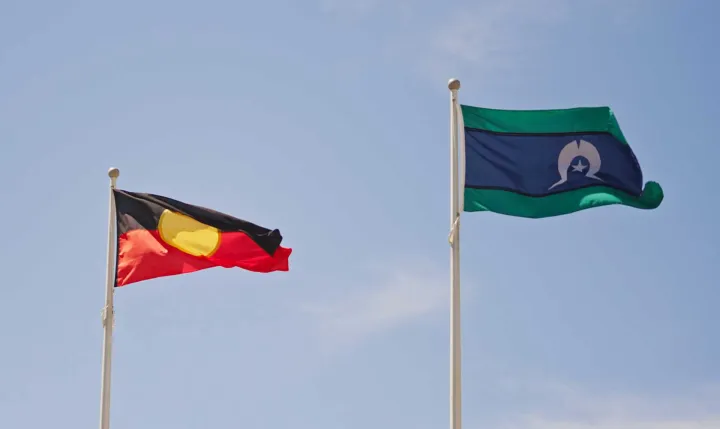
Credit: National Indigenous Australians Agency
Aboriginal Flag
The Aboriginal Flag was designed by Luritja artist Harold Thomas and first flown in support of land rights in July 1971 at Tarntanyangga (Victoria Square, Adelaide).
The Flag’s design is simple yet powerful: black represents the Aboriginal people, red symbolises the earth and Aboriginal people’s spiritual connection to it, and the yellow circle stands for the life-giving sun.
The Aboriginal Flag quickly became an emblem of strength and resilience and in July 1995 it was proclaimed an official flag of Australia. Today, the Flag is flown proudly across the country, from public buildings and bridges to sporting events. It continues to represent the enduring culture, heritage and rights of Aboriginal people.
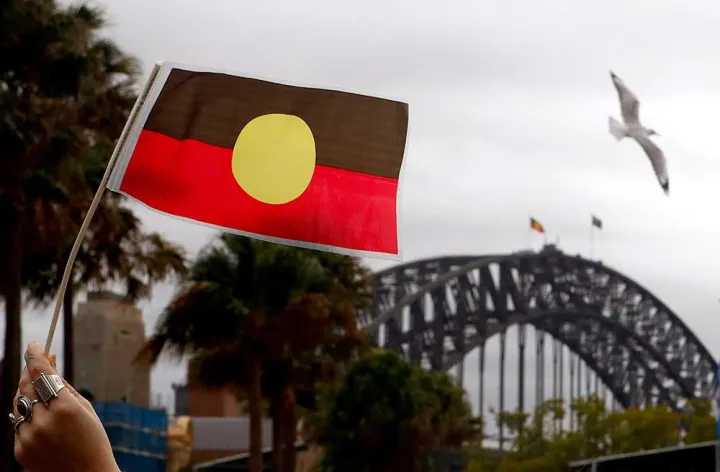
Credit: AAP/Daniel Munoz
Torres Strait Islander Flag
The Torres Strait Islander Flag was designed in 1992 by the late Mr Bernard Namok of Thursday Island. In May 1992 at the sixth Torres Strait Cultural Festival, it was adopted as the official flag of the Torres Strait Islands and in July 1995 it was proclaimed an official flag of Australia. Today, the Flag is a symbol of pride for Torres Strait Islander people.
In the following video (narrated in Torres Strait Creole and English), Bernard Namok Junior explores the story behind the creation of the Torres Strait Islander Flag and how the creator, his father, incorporated different elements to showcase the rich history of Torres Strait culture and the shared history with Aboriginal people.
The Torres Strait Islander Flag features green, blue, black and white. The green stripes signify the land, the blue represents the sea, the black lines symbolise the Torres Strait Islander people, and the white Dhari (a ceremonial headdress) and star highlight peace, unity and navigation.
Our Flag, Our Story: The Torres Strait Islander Flag by Bernard Namok Jnr, Thomas Mayo and illustrated by Tori-Jay Mordey, published by Magabala Books (Broome, WA), 2024.
Pride in the Flags
The Aboriginal and Torres Strait Islander Flags hold deep meaning for their peoples, symbolising survival, resilience and connection. They evoke strong emotions and are powerful reminders of identity and unity. For many, these Flags are deeply personal, representing a shared history and the strength to persevere through adversity with pride.
Credit: National Indigenous Australians Agency
The Flags at Mardi Gras
In 1982, the Aboriginal Flag made its first appearance at Mardi Gras. Roger McKay, an activist from Narrandera, marched alone in the parade wearing the Flag as a cape around his neck.
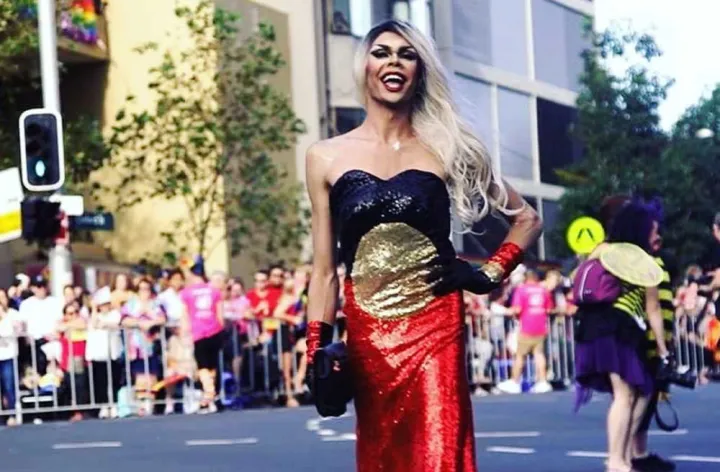
Aboriginal drag queen Felicia Foxx wears a sequined dress in red, black, yellow colours at the Sydney Mardi Gras. Credit: Barbara McGrady
In 1988, the first Aboriginal and Torres Strait Islander float entered the parade, led by dancer Malcolm Cole. Each year, the visibility of the First Nations queer community presence at Mardi Gras grows in size and scale.
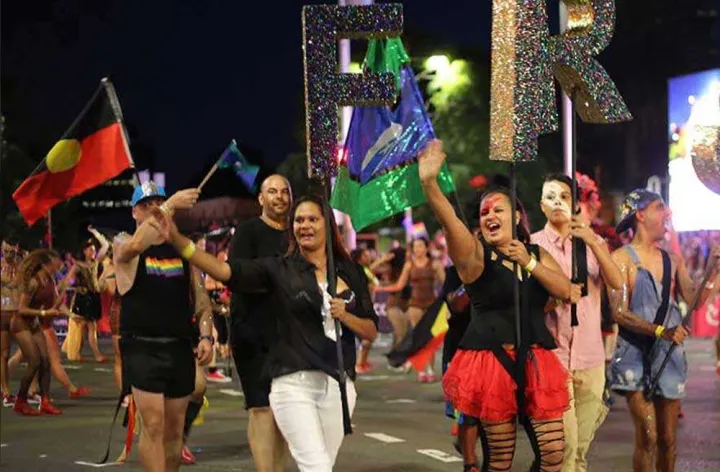
A group of people holding the Aboriginal and Torres Strait Islander flags march in front of the First Nations float during Sydney’s Mardi Gras parade. Credit: SBS
Bicentenary protests
In 1988 in Sydney, the protests against Australia’s Bicentenary, which marked 200 years since British colonisation, saw over 40,000 Aboriginal and Torres Strait Islander people and their allies march together.
The protests were among Australia’s largest Indigenous-led protests. They served to highlight the devastating impacts of colonisation, dispossession and cultural erasure, with protestors demanding recognition, justice and land rights for Aboriginal and Torres Strait Islander people.
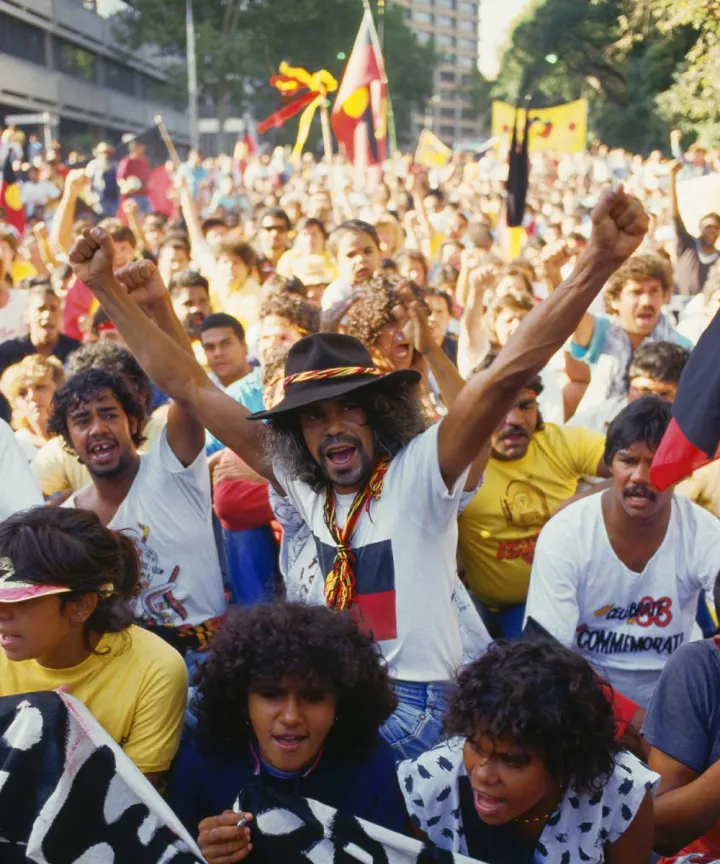
Credit: Getty Images/Penny Tweedie
Aboriginal Tent Embassy
On 26 January 1972, Michael Anderson, Billy Craigie, Bertie Williams and Tony Coorey, four First Nations men, set up a beach umbrella on the lawns opposite Parliament House in Canberra, declaring it the Aboriginal Embassy.
The protest was a response to then Prime Minister William McMahon’s policy rejecting Indigenous land ownership in favour of restrictive 50-year leases.
Aboriginal Activist Gary Foley described the embassy as symbolic, stating First Nations people were treated as “aliens in our own land.”
The embassy evolved over time, advocating for land rights, sovereignty and self-determination, and became a permanent fixture on those same lawns in 1992.
In 1995 the Aboriginal Tent Embassy was listed on the Register of the National Estate; the only site on the Register noted as important due to its political significance to Indigenous Australians.
The Aboriginal Tent Embassy remains one of the world’s longest-running protest sites.
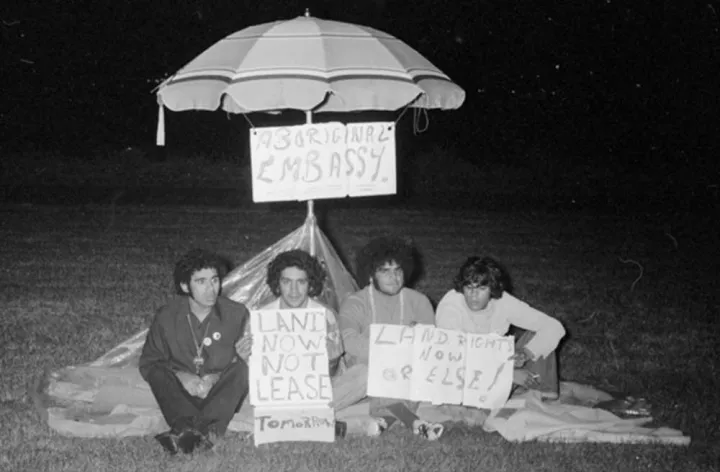
Credit: Mitchell Library, State Library of New South Wales and Courtesy SEARCH Foundation/Noel Hazard.
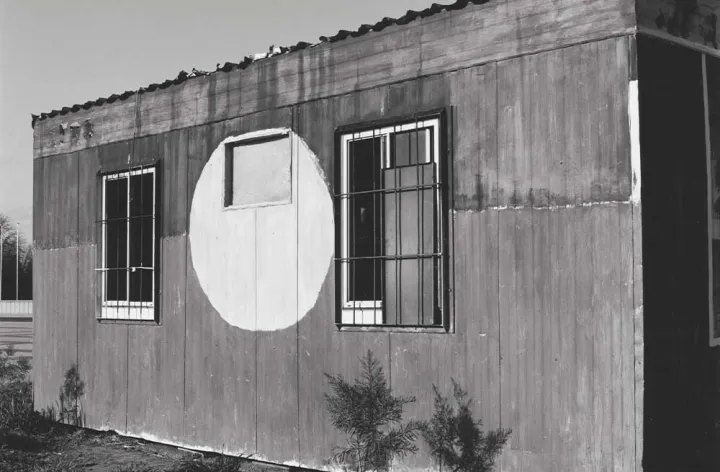
Credit: National Library of Australia/Loui Seselja
25th anniversary of the Torres Strait Islander Flag
‘Carry the Flag’ was developed to mark the 25th anniversary of the design of the Torres Strait Islander Flag. It charts the extraordinary story of how one man’s design brought identity and recognition to a people by mainland Australia.
Venture into the Straits with Bernard Namok Jr as he reflects on the life and enduring legacy of his late father, Bernard Namok Senior, the creative mind behind this powerful symbol.
Credit: Tamarind Tree Pictures
Cathy Freeman
Cathy Freeman’s milestone gold medal victory in the 400m at the 2000 Sydney Olympics was a powerful nation-wide iconic moment.
Carrying both the Australian and Aboriginal Flags during her victory lap, Freeman inspired the nation. Our Indigenous communities in particular felt pride knowing the world was watching.
As a symbol of the hope for reconciliation, Freeman’s win remains a landmark moment in Australia’s sporting and cultural history that will never be forgotten.
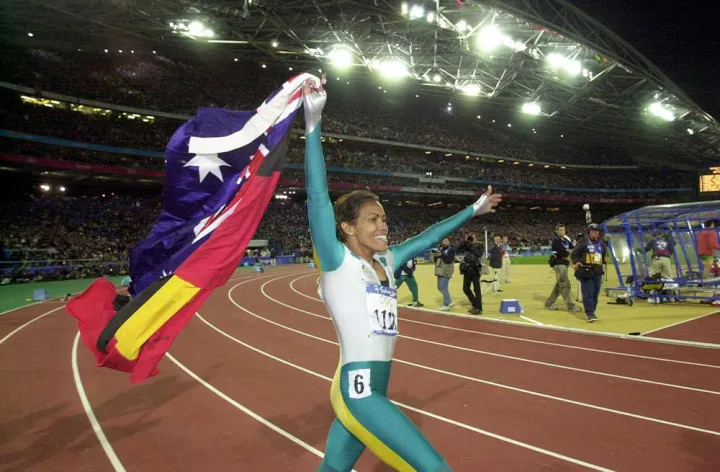
Credit: AAP/Dean Lewins
Adam Goodes
When Sydney Swans AFL player Adam Goodes wore a mouthguard in the colours of the Aboriginal Flag, he made a powerful statement of cultural pride and visibility. This simple yet meaningful gesture honoured his heritage and promoted Indigenous representation in Australian sport.
In his last year playing AFL, Goodes faced intense scrutiny and increasing racism, ultimately leading to his retirement in 2015. His courage to stand against racial abuse sparked important conversations about identity, inclusion and respect for First Nations communities, leaving a lasting legacy in both Australian sport and society.

Credit: Getty Images/Hamish Blair
Sydney Harbour Bridge
After years of petitioning and debate, the Aboriginal Flag now flies permanently alongside the Australian Flag atop the Sydney Harbour Bridge. This globally recognised landmark stands as a symbol of the city.
The permanent presence of the Aboriginal Flag is seen as an important and historic step towards visibility and recognition of First Nations people and a move towards reconciliation.
Credit: SBS World News
Winds of Zenadth
At the Winds of Zenadth Cultural Festival on Thursday Island in the Torres Strait, community members proudly march holding the Torres Strait Islander Flag.
This annual festival has been running since 1987 and celebates the people and culture of Zenadth Kes region, commonly known as the Torres Strait Islands. Held over several days, the festival features local dance groups, arts and jewellery, traditional foods and speeches by cultural leaders.
For more information visit the Torres Strait Island Regional Council www.tsirc.qld.gov.au
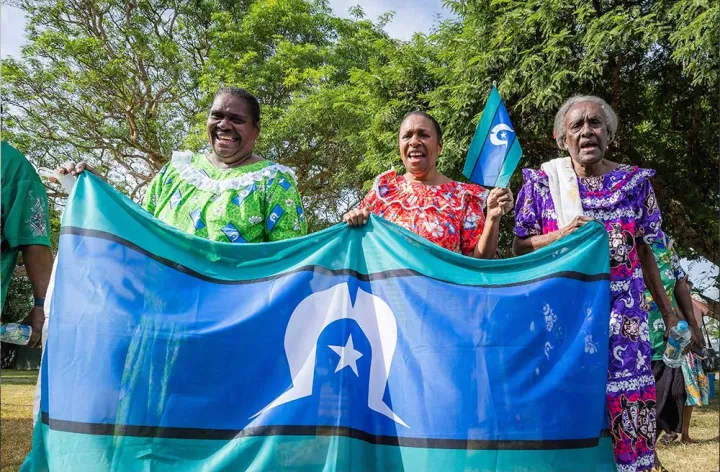
Credit: AAP/Tyr Liang
Australian War Memorial
The Aboriginal and Torres Strait Flags that fly at the Australian War Memorial honour the First Nations men and women who served in the Australian Defence Forces, and acknowledge the great hardships they endured.
These Flags pay respect to the sacrifices of those who served, even when their voices were unheard. Both represent a powerful step towards reconciliation and act as symbols of hope for change and recognition of Indigenous peoples’ service to this country.
Credit: National Indigenous Australians Agency
Elders
Elders hold a special place in Aboriginal and Torres Strait Islander cultures. They are treated with respect and care, and their knowledge, experience and values are seen as pillars of culture.
An Elder’s lived experience, personal history, traditional knowledge and stories are often passed down to younger generations, providing a crucial connection from our past to our future.
Credit: National Indigenous Australians Agency